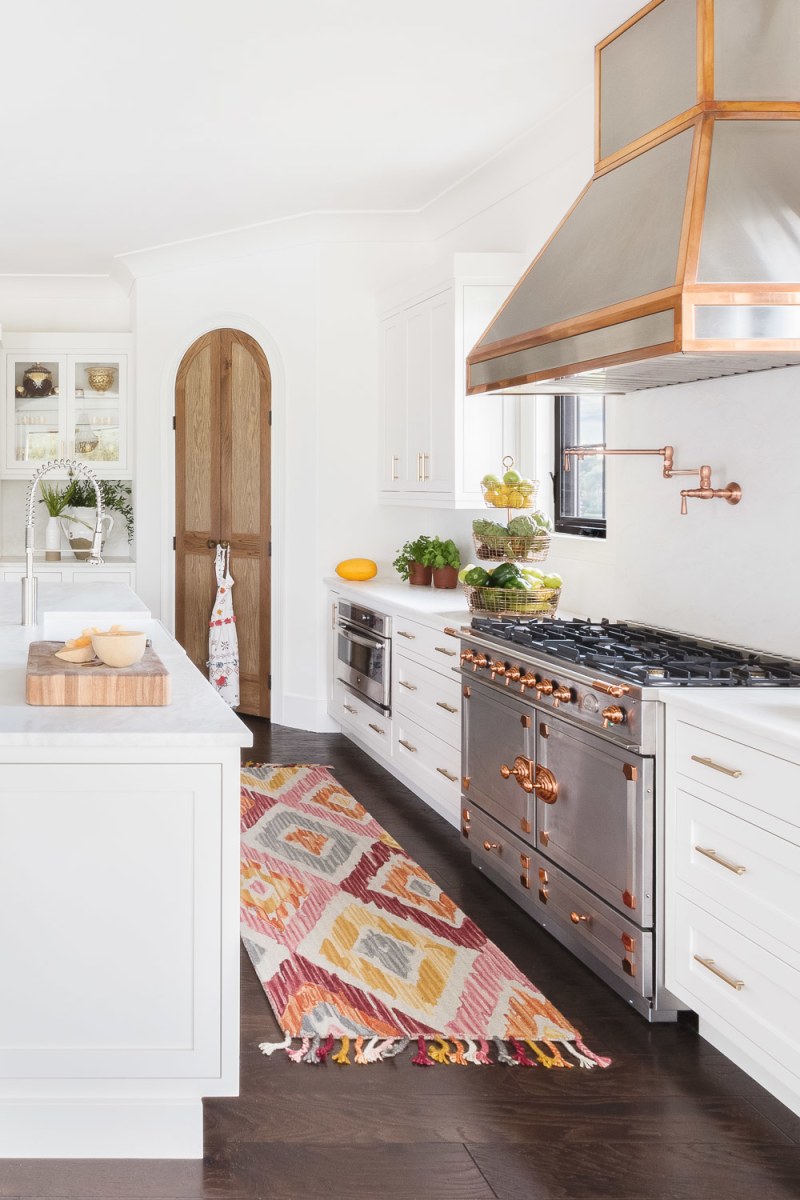We may earn revenue from the products available on this page and participate in affiliate programs.
From dishes that somehow, ceaselessly, pile up in the sink to cabinets that end up overflowing with one, two, or inexplicably three cans of tomato paste because you keep forgetting that you already own it for that one recipe you’ve been meaning to try, the kitchen can get messy. And if anyone knows their way around cleaning up a cooking space and keeping it that way, it’s a chef.
Whether they’re working in a restaurant or whipping up a meal at home, food professionals devise strict industry kitchen organizing tips and tricks that can prevent major cooking headaches and, in turn, make spending time in the kitchen a lot more fun. For the home cook who might just be starting out with a new meal-prep routine to the seasoned dinner party host, these tips, courtesy of seasoned chefs, will make your kitchen run smoothly. Take note.
Tackle the Spice Rack

“Buy your spices in bulk—they will be much cheaper—and keep them all in sealed, tight containers,” advises Dave Anoia of Pittsburgh’s DiAnoia’s Eatery. If you have 20 different types of spices, you can get five different small plastic containers with lids and keep the excess in plastic bags in the containers.” When you put your spices in all the same size containers, they can be better organized on a shelf or rack.
That’s not all. Nick Korbee, executive chef of New York City’s Egg Shop adds: “Alphabetized spice racks will change your life. Line them up, keep them straight, and never look back. This helps prepare food faster and saves money when it’s time to re-up those premium pantry ingredients.”
Reassess Your Utensils

The utensil drawer can get easily disorganized with kitchen tools you don’t need, those you can’t seem to find, and, honestly, junk. Luckily, there are ways to prevent this.
“I find that a lot of home cooks have a set of dull knives in a wooden block or just a bunch of knives thrown together in a drawer,” says Tony Galzin, owner and executive chef of Nicky’s Coal Fired in Nashville. “You should have a couple nicer knives that are kept sharp and on a clean folded kitchen towel, either on the counter or neatly in a drawer.” We also recommend holding onto just a few knives that you know you’ll actually use.
To further keep your drawers and cabinets neat, Laurence Edelman, chef and owner of New York’s Left Bank advises to, “Buy items that stack well and are in sets. Mismatched items tend to take up way more room. And reconsider items like a salad spinner. Do you really use it enough to justify the clutter?” It might just be time to Kondo your cooking tool collection.
Once you’ve bid unnecessary clutter farewell, keep things neat with the right containers. “For the frequently used spatulas and tongs, you can buy a ceramic or marble utensil holder for the counter. It’s both aesthetically pleasing and incredibly useful,” says Lyndi Stein, owner of culinary experience company Juniper Green.
Date Your Groceries

Properly storing your groceries sometimes just isn’t enough, especially if your food doesn’t come with a best-buy date. To prevent both food waste and refrigerator clutter, Dez’s co-founder and executive chef Eden Grinshpan advises: “Keep tape and Sharpies close by to date your food. I find that people throw away too much food because they are not labeling.”
Toss the Packaging

Ever see a covetable image on Instagram of a neat cabinet filled with decanted rice, grains, and more? The owner is onto something. Many chefs advise decanting your groceries to make for easier storage. “Take things out of the box,” says Korbee. “Just the simple act of taking purchased items out of their packaging and putting them in a container you care about is enough to ensure you will actually use the stuff and prolong the shelf life.”
It’s a pretty simple job, too, and one that can be done with the help of affordable containers. “For pantries with large shelving, I love using the wide-mouth Ball jars to store grains, nuts, and dried fruit and labeling them accordingly,” Stein adds. “It makes it easy to find and replenish your stash and prevents you from using plastic. Plus, it’s a breath of fresh air when you open that pantry and see everything all in a row.”
Keep It Tidy

Once you’ve made your kitchen as clean as it can be and implemented new kitchen organizing tips, keep things tidy by abiding by a simple motto.
Matt Aita, the executive chef of The Little Beet Table, advises: “There is a French phrase that you hear in kitchens around the world that defines how chefs keep their kitchens organized and clean: mise en place. It means ‘putting in place’ or ‘everything in its place.’ When we work, this mantra is our guide as we prep or cook on the line. When you intentionally have a place or plan for everything you are doing in the kitchen, it becomes much easier to work and to navigate.”
See more kitchen advice: 17 Products on Amazon That Will Help Simplify Your Life Chic Alternatives to Your Sad Ziploc Bags and Tupperware This Genius Product Is the Single Best Way to Organize Your Pantry
